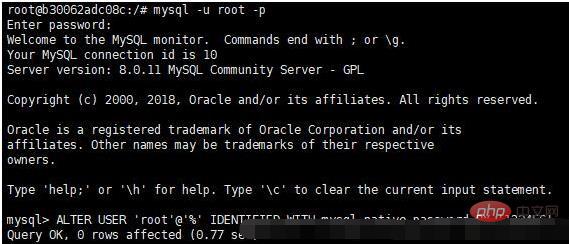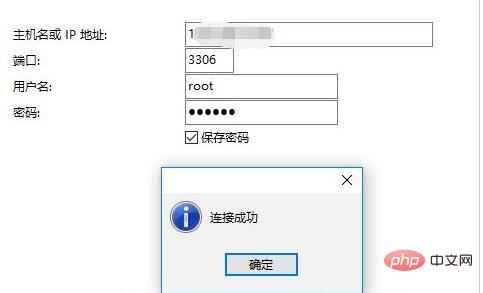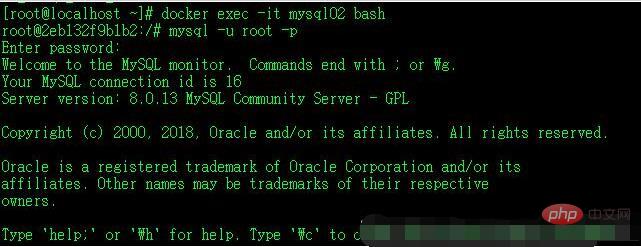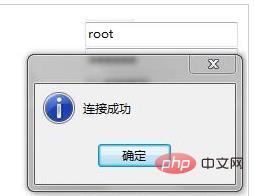What should I do if docker fails to connect to mysql?
Solution to the failure of docker to connect to mysql: 1. Check the running container through the "docker ps" command; 2. Run "docker exec -it b30062adc08c /bin/bash" to enter the mysql container; 3. Enter " mysql -u root -p" command; 4. Restart mysql, and then use navicat to connect successfully.

The operating environment of this tutorial: linux7.3 system, docker version 19.03, Dell G3 computer.
What should I do if docker fails to connect to mysql?
Solution to failure in connecting to mysql in docker
Scenario: After installing the latest version of mysql in the docker container of the virtual machine, use navicat in the host to connect to the virtual machine. Mysql displays the following error:

2059: Authentication plugin 'caching_sha2_password' cannot be loaded:
Solution:
1. First, use the docker ps command to check the running container and make sure that the mysql we want to connect to has been started. If it has not started, use the docker start command to start it (see the result in the picture below) Indicates that a mysql has been started)


ALTER USER 'root'@'%' IDENTIFIED WITH mysql_native_password BY '123456';
 ##4. Finally, restart mysql and use navicat to connect successfully
##4. Finally, restart mysql and use navicat to connect successfully

Supplementary knowledge: Solution to the MySQL error in local remote connection Docker (1251)The error is as follows:
 Cause: mysql 8.0 uses the cache_sha2_password authentication mechanism by default; the client does not support the new encryption method
Cause: mysql 8.0 uses the cache_sha2_password authentication mechanism by default; the client does not support the new encryption method
1. Enter the mysql container and enter
docker exec -it mysql02 bash in docker 2. Log in to mysql
in docker 2. Log in to mysql
Enter 123456 and press Enter as shown
 3. Set user configuration items
3. Set user configuration items
(1) View user information
select host,user,plugin,authentication_string from mysql.user;(2) Modify the encryption methodALTER USER 'root'@'%' IDENTIFIED WITH mysql_native_password BY '123456'; //123456 is the login password for mysql
(3) Check user information againselect host,user,plugin,authentication_string from mysql.user;
 (4 ) Use Navicate and other database software to connect again, successfully
(4 ) Use Navicate and other database software to connect again, successfully
 (5)
(5)
Supplement:If you want to exit normally without closing the container, You can exit the container by pressing Ctrl P QExit the container from mysql: Ctrl D, press twice
Recommended learning: "
docker video tutorialThe above is the detailed content of What should I do if docker fails to connect to mysql?. For more information, please follow other related articles on the PHP Chinese website!

Hot AI Tools

Undresser.AI Undress
AI-powered app for creating realistic nude photos

AI Clothes Remover
Online AI tool for removing clothes from photos.

Undress AI Tool
Undress images for free

Clothoff.io
AI clothes remover

Video Face Swap
Swap faces in any video effortlessly with our completely free AI face swap tool!

Hot Article

Hot Tools

Notepad++7.3.1
Easy-to-use and free code editor

SublimeText3 Chinese version
Chinese version, very easy to use

Zend Studio 13.0.1
Powerful PHP integrated development environment

Dreamweaver CS6
Visual web development tools

SublimeText3 Mac version
God-level code editing software (SublimeText3)

Hot Topics
 How to exit the container by docker
Apr 15, 2025 pm 12:15 PM
How to exit the container by docker
Apr 15, 2025 pm 12:15 PM
Four ways to exit Docker container: Use Ctrl D in the container terminal Enter exit command in the container terminal Use docker stop <container_name> Command Use docker kill <container_name> command in the host terminal (force exit)
 How to check the name of the docker container
Apr 15, 2025 pm 12:21 PM
How to check the name of the docker container
Apr 15, 2025 pm 12:21 PM
You can query the Docker container name by following the steps: List all containers (docker ps). Filter the container list (using the grep command). Gets the container name (located in the "NAMES" column).
 How to restart docker
Apr 15, 2025 pm 12:06 PM
How to restart docker
Apr 15, 2025 pm 12:06 PM
How to restart the Docker container: get the container ID (docker ps); stop the container (docker stop <container_id>); start the container (docker start <container_id>); verify that the restart is successful (docker ps). Other methods: Docker Compose (docker-compose restart) or Docker API (see Docker documentation).
 How to copy files in docker to outside
Apr 15, 2025 pm 12:12 PM
How to copy files in docker to outside
Apr 15, 2025 pm 12:12 PM
Methods for copying files to external hosts in Docker: Use the docker cp command: Execute docker cp [Options] <Container Path> <Host Path>. Using data volumes: Create a directory on the host, and use the -v parameter to mount the directory into the container when creating the container to achieve bidirectional file synchronization.
 How to start mysql by docker
Apr 15, 2025 pm 12:09 PM
How to start mysql by docker
Apr 15, 2025 pm 12:09 PM
The process of starting MySQL in Docker consists of the following steps: Pull the MySQL image to create and start the container, set the root user password, and map the port verification connection Create the database and the user grants all permissions to the database
 How to update the image of docker
Apr 15, 2025 pm 12:03 PM
How to update the image of docker
Apr 15, 2025 pm 12:03 PM
The steps to update a Docker image are as follows: Pull the latest image tag New image Delete the old image for a specific tag (optional) Restart the container (if needed)
 Docker Volumes: Managing Persistent Data in Containers
Apr 04, 2025 am 12:19 AM
Docker Volumes: Managing Persistent Data in Containers
Apr 04, 2025 am 12:19 AM
DockerVolumes ensures that data remains safe when containers are restarted, deleted, or migrated. 1. Create Volume: dockervolumecreatemydata. 2. Run the container and mount Volume: dockerrun-it-vmydata:/app/dataubuntubash. 3. Advanced usage includes data sharing and backup.
 How to start containers by docker
Apr 15, 2025 pm 12:27 PM
How to start containers by docker
Apr 15, 2025 pm 12:27 PM
Docker container startup steps: Pull the container image: Run "docker pull [mirror name]". Create a container: Use "docker create [options] [mirror name] [commands and parameters]". Start the container: Execute "docker start [Container name or ID]". Check container status: Verify that the container is running with "docker ps".






